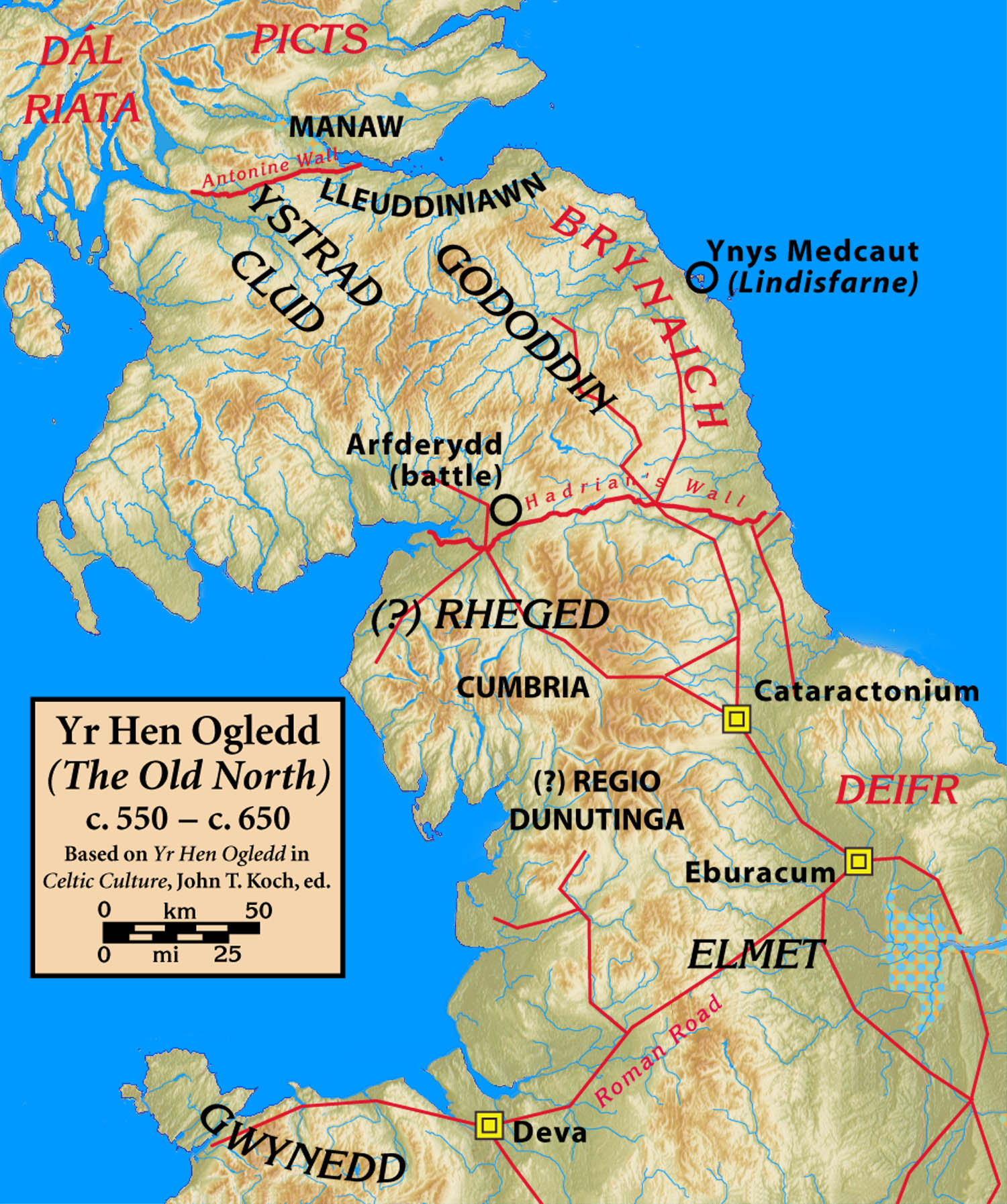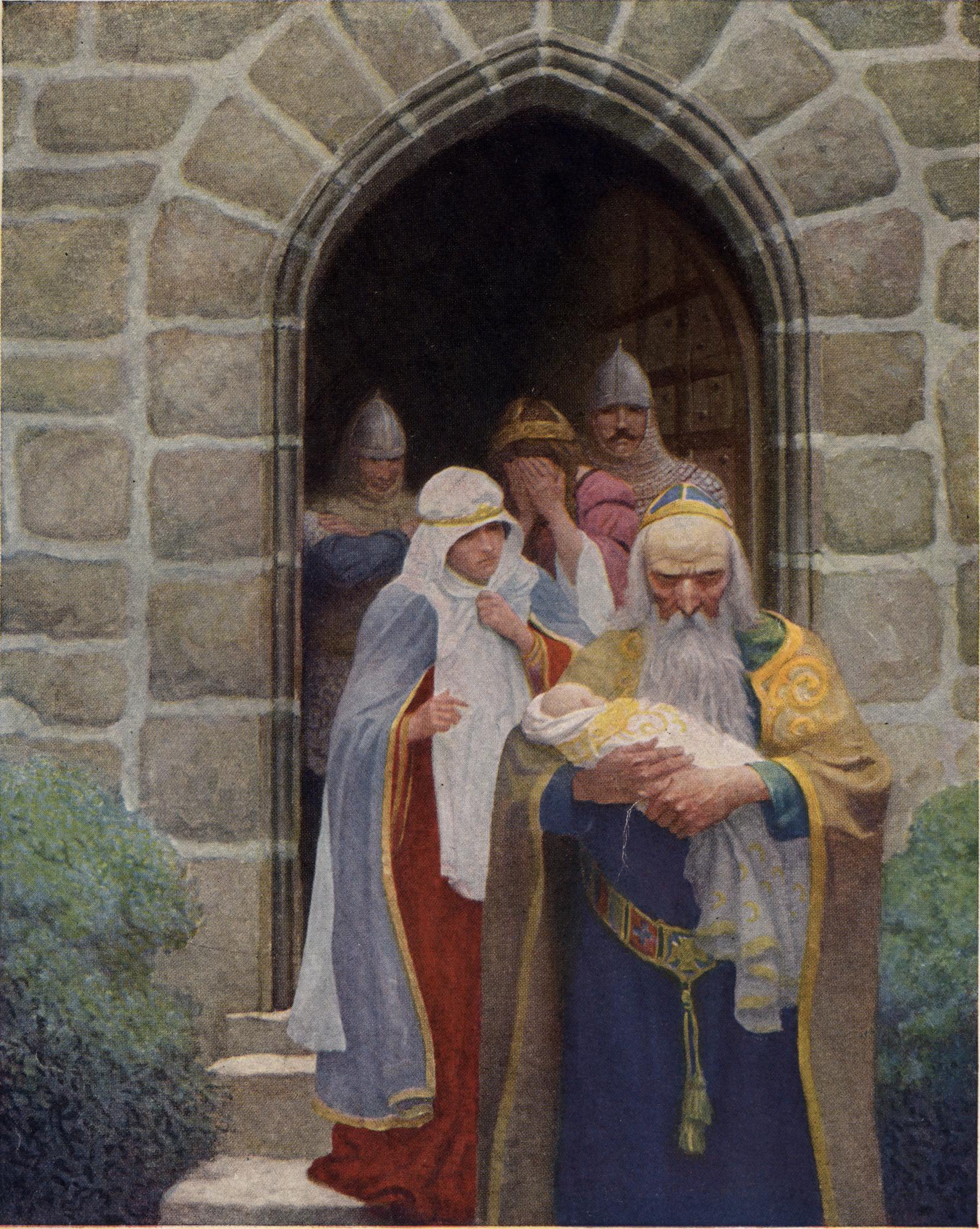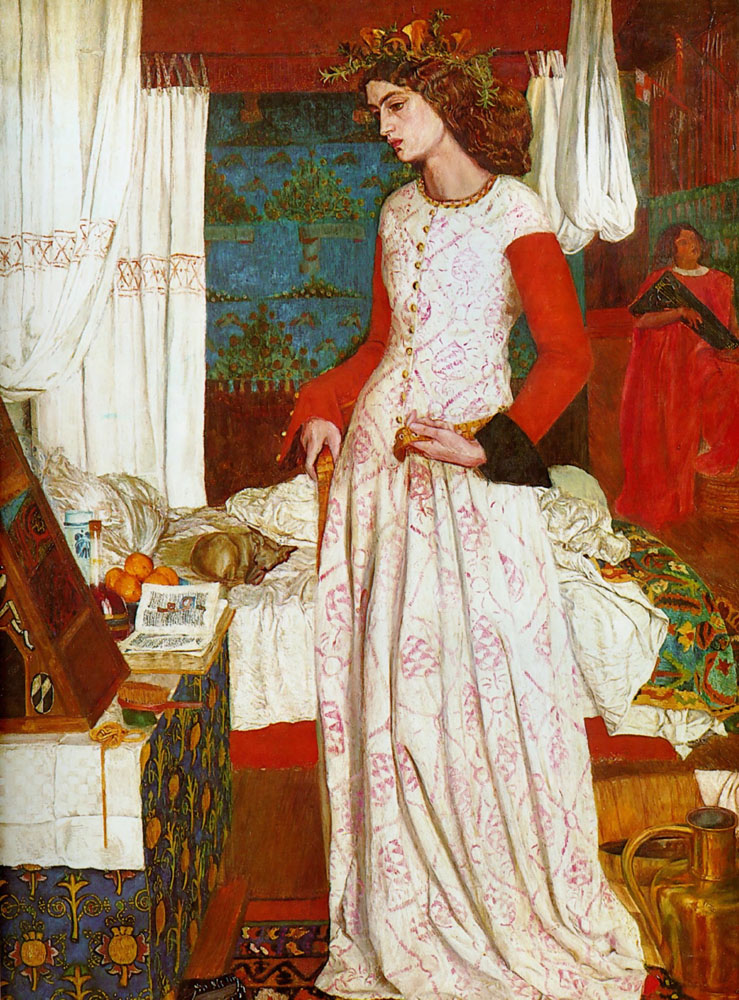|
Cynon Ap Clydno
Cynon ap Clydno or in some translations KynonIn her translation of ''The Mabinogion'', Guest uses the spelling Kynon, but in the notes to her translation she acknowledges the character as Cynon ap Clydno or Cynan was an Arthurian hero from Welsh mythology. His quest to the ''Castle of Maidens'' and his subsequent trial against the Black Knight, serve as a prelude to the adventure of Owain and The Lady of the Fountain. Cynon is closely associated with Sir Calogrenant, who takes his role in other versions of the tale. History Cynon was the son of Clydno Eiddin, a ruler of Eidyn in the Hen Ogledd, the Brittonic-speaking parts of northern England and southern Scotland in the Early Middle Ages. Both Clydno and Cynon were figures in Welsh tradition. The poem ''Y Gododdin'' names Cynon as one of the Britons who fought against the Angles at the disastrous Battle of Catraeth; and is named as one of the four survivors, along with the author of the poem, Aneirin.Guest (2002), p.305 Aneir ... [...More Info...] [...Related Items...] OR: [Wikipedia] [Google] [Baidu] |
Mabinogion - Owain Or Cynon Shelter From A Hailstorm
The ''Mabinogion'' () is a collection of the earliest Welsh prose stories, compiled in Middle Welsh in the 12th–13th centuries from earlier oral traditions. There are two main source manuscripts, created –1410, as well as a few earlier fragments. Often included in the broader mythologies described as the Matter of Britain, the Mabinogion consists of eleven stories of widely different types, offering drama, philosophy, romance, tragedy, fantasy and humour. Strictly speaking, the Four Branches of the Mabinogi are the main sequence of related tales, but seven others include a classic hero quest, "Culhwch and Olwen"; a historic legend, complete with glimpses of a far off age, in "Lludd and Llefelys"; and other tales portraying a very different King Arthur from the later popular versions. The stories were created and amended by various narrators over a very long period of time, and scholars beginning from the 18th century predominantly viewed the tales as fragmentary pre-Christi ... [...More Info...] [...Related Items...] OR: [Wikipedia] [Google] [Baidu] |
Urien Rheged
Urien ap Cynfarch Oer () or Urien Rheged (, Old Welsh: or , ) was a powerful sixth-century Common Brittonic, Brittonic-speaking figure who was possibly the ruler of the territory or kingdom known as Rheged. He is one of the best-known and best documented of the Ancient Britons, British figures of the 'Yr Hen Ogledd, Old North'. His kingdom was most likely centred around the Solway Firth. According to the ''Historia Brittonum'' (), Urien gained the decisive advantage in a conflict against the Anglo-Saxons in northern Britain led an alliance with three other kings: Rhydderch Hen, Gwallog ap Llênog, and Morcant Bulc, Morgan. The alliance led by Urien penned the Anglo-Saxons in at Lindisfarne, though this siege came to an abrupt end when Urien was murdered on the orders of his erstwhile ally Morgan. The most secure evidence for his existence comes the ''Historia Brittonum'' and eight Panegyric, praise-poems in Middle Welsh dedicated to him surviving in a Book of Taliesin, four ... [...More Info...] [...Related Items...] OR: [Wikipedia] [Google] [Baidu] |
Irish Mythology
Irish mythology is the body of myths indigenous to the island of Ireland. It was originally Oral tradition, passed down orally in the Prehistoric Ireland, prehistoric era. In the History of Ireland (795–1169), early medieval era, myths were Early Irish literature, written down by Celtic Christianity, Christian scribes, who Christianized them to some extent. Irish mythology is the best-preserved branch of Celtic mythology. The myths are conventionally grouped into 'List of literary cycles, cycles'. The Mythological Cycle consists of tales and poems about the god-like Tuatha Dé Danann, who are based on Ireland's pagan deities, and other mythical races like the Fomorians. Important works in the cycle are the ''Lebor Gabála Érenn'' ("Book of Invasions"), a legendary history of Ireland, the ''Cath Maige Tuired'' ("Battle of Moytura"), and the ''Aided Chlainne Lir'' ("Children of Lir"). The Ulster Cycle consists of heroic legends relating to the Ulaid, the most important of whi ... [...More Info...] [...Related Items...] OR: [Wikipedia] [Google] [Baidu] |
Fomorians
The Fomorians or Fomori (, Modern ) are a supernatural race in Irish mythology, who are often portrayed as hostile and monstrous beings. Originally they were said to come from under the sea or the earth. Later, they were portrayed as sea raiders and giants. They are enemies of Ireland's first settlers and opponents of the Tuatha Dé Danann, the other supernatural race in Irish mythology; although some members of the two races have offspring. The Tuath Dé defeat the Fomorians in the '' Battle of Mag Tuired''. This has been likened to other Indo-European myths of a war between gods, such as the Æsir and Vanir in Norse mythology, the Olympians and Titans in Greek mythology, and the Devas and Asuras in Indian mythology. One theory is that the Fomorians were supernatural beings representing the wild or destructive powers of nature; personifications of chaos, darkness, death, blight and drought. Name In Old and Middle Irish, the race is usually called the ''Fomóire'' or '' ... [...More Info...] [...Related Items...] OR: [Wikipedia] [Google] [Baidu] |
Guinevere
Guinevere ( ; ; , ), also often written in Modern English as Guenevere or Guenever, was, according to Arthurian legend, an early-medieval queen of Great Britain and the wife of King Arthur. First mentioned in literature in the early 12th century, nearly 700 years after the purported times of Arthur, Guinevere has since been portrayed as everything from a fatally flawed, villainous, and opportunistic traitor to a noble and virtuous lady. The variably told motif of abduction of Guinevere, or of her being rescued from some other peril, features recurrently and prominently in many versions of the legend. The earliest datable appearance of Guinevere is in Geoffrey of Monmouth's pseudo-historical British chronicle ''Historia Regum Britanniae'', in which she is seduced by Mordred during his ill-fated rebellion against Arthur. In a later medieval Arthurian romance tradition from France, a major story arc is the queen's tragic love affair with her husband's best knight and trusted f ... [...More Info...] [...Related Items...] OR: [Wikipedia] [Google] [Baidu] |
Caerleon
Caerleon ( ; ) is a town and Community (Wales), community in Newport, Wales. Situated on the River Usk, it lies northeast of Newport city centre, and southeast of Cwmbran. Caerleon is of archaeological importance, being the site of a notable Roman Empire, Roman legionary Castra, fortress, Isca Augusta, and an Iron Age hillfort. Close to the remains of Isca Augusta are the National Roman Legion Museum and the Roman Baths Museum. The town also has strong historical and literary associations: Geoffrey of Monmouth elevated the significance of Caerleon as a major centre of British history in his ''Historia Regum Britanniae'' (c. 1136), and Alfred Lord Tennyson wrote ''Idylls of the King'' (1859–1885) while staying in Caerleon. History Pre-Roman history The area around Caerleon is of considerable archaeological interest, with a number of important Neolithic sites. By the British Iron Age, Iron Age, the area was home to the powerful Silures tribe and appears to have been the centr ... [...More Info...] [...Related Items...] OR: [Wikipedia] [Google] [Baidu] |
Mabinogion
The ''Mabinogion'' () is a collection of the earliest Welsh prose stories, compiled in Middle Welsh in the 12th–13th centuries from earlier oral traditions. There are two main source manuscripts, created –1410, as well as a few earlier fragments. Often included in the broader mythologies described as the Matter of Britain, the Mabinogion consists of eleven stories of widely different types, offering drama, philosophy, romance, tragedy, fantasy and humour. Strictly speaking, the Four Branches of the Mabinogi are the main sequence of related tales, but seven others include a classic hero quest, "Culhwch and Olwen"; a historic legend, complete with glimpses of a far off age, in "Lludd and Llefelys"; and other tales portraying a very different King Arthur from the later popular versions. The stories were created and amended by various narrators over a very long period of time, and scholars beginning from the 18th century predominantly viewed the tales as fragmentary pre-Christi ... [...More Info...] [...Related Items...] OR: [Wikipedia] [Google] [Baidu] |
The Black Book Of Carmarthen
The Black Book of Carmarthen () is thought to be the earliest surviving manuscript written solely in Welsh. The book dates from the mid-13th century; its name comes from its association with the Priory of St. John the Evangelist and Teulyddog at Carmarthen, and is referred to as black due to the colour of its binding. It is currently part of the collection of the National Library of Wales, where it is catalogued as NLW Peniarth MS 1. This was one of the collection of manuscripts amassed at the mansion of Hengwrt, near Dolgellau, Gwynedd, by Welsh antiquary Robert Vaughan (c.1592–1667); the collection later passed to the newly established National Library of Wales as the Peniarth or Hengwrt-Peniarth Manuscripts. It is believed that the manuscript is first recorded when it came into the possession of Sir John Price of Brecon (1502?–1555), whose work was to search the monasteries dissolved by Henry VIII. It was given to him by the treasurer of St David's Cathedral, havin ... [...More Info...] [...Related Items...] OR: [Wikipedia] [Google] [Baidu] |
Igraine
In the Matter of Britain, Igraine () is the mother of King Arthur. Igraine is also known in Latin as Igerna, in Welsh as Eigr (Middle Welsh Eigyr), in French as Ygraine (Old French Ygerne or Igerne), in ''Le Morte d'Arthur'' as Ygrayne—often modernised as Igraine or Igreine—and in ''Parzival'' as Arnive. She becomes the wife of Uther Pendragon, after the death of her first husband, Gorlois. Legend In Geoffrey of Monmouth's ''Historia Regum Britanniae'', Igerna enters the story as the wife of Gorlois, Duke of Cornwall. In Thomas Malory's ''Le Morte d'Arthur'', her daughters by Gorlois are Elaine, Morgause and Morgan le Fay. In other works, the names, roles and even number of Arthur's half-sisters vary depending on the text (including none in the ''Historia'', in which Arthur has only a younger sister). In the '' Brut Tysilio'', Cador of Cornwall is their son. John Hardyng's ''Chronicle'' calls Cador Arthur's brother "of his mother's syde". Geoffrey describes her as ... [...More Info...] [...Related Items...] OR: [Wikipedia] [Google] [Baidu] |
Uther Pendragon
Uther Pendragon ( ; the Brittonic languages, Brittonic name; , or ), also known as King Uther (or Uter), was a List of legendary kings of Britain, legendary King of the Britons and father of King Arthur. A few minor references to Uther appear in Old Welsh language, Old Welsh Medieval Welsh literature, poems, but his biography was first written down in the 12th century by Geoffrey of Monmouth in his ''Historia Regum Britanniae'' (''History of the Kings of Britain''), and Geoffrey's account of the character was used in most later versions. He is a fairly ambiguous individual throughout the literature, but is described as a strong king and a defender of his people. According to Matter of Britain, Arthurian legend, Merlin magically Shapeshifting, disguises Uther to look like his enemy Gorlois, enabling Uther to sleep with Gorlois' wife Lady Igraine. Thus Arthur, "the once and future king", is an illegitimate child (though later legend, as found in Thomas Malory, Malory, emphasis ... [...More Info...] [...Related Items...] OR: [Wikipedia] [Google] [Baidu] |
Iseult
Iseult ( ), alternatively Isolde ( ) and other spellings, is the name of several characters in the legend of Tristan and Iseult. The most prominent is Iseult the Blonde, or Iseult of Ireland, the wife of Mark of Cornwall and the lover of Tristan. Her mother, the queen of Ireland, is also named Iseult. The third is Iseult of the White Hands, or Iseult of Brittany, the daughter of Hoel and the sister of Kahedin. Name Her name is variably given as most commonly either Iseult or Isolde, but also may appear as Yseult, Ysolt, Isolt, Isode, Isoude, Iseut, Isaut (Old French), Iosóid (Irish), Esyllt (Welsh), Ysella (Cornish), Isolda (Portuguese, Spanish), Izolda (Serbian) and Isotta (Italian), among other forms. The oldest source, Béroul's 12th-century romance, spells her name as ''Yseut'' or ''Iseut''. The etymology is uncertain, with most sources linking it to the Old High German words ''īs'' ("ice") and ''hiltja'' ("battle"). Other writers derive it from a Brythonic *''Adsilt ... [...More Info...] [...Related Items...] OR: [Wikipedia] [Google] [Baidu] |
Tristan
Tristan (Latin/ Brythonic: ''Drustanus''; ; ), also known as Tristran or Tristram and similar names, is the folk hero of the legend of Tristan and Iseult. While escorting the Irish princess Iseult to wed Tristan's uncle, King Mark of Cornwall, Tristan and Iseult accidentally drink a love potion during the journey and fall in love, beginning an adulterous relationship that eventually leads to Tristan's banishment and death. The character's first recorded appearance is in the 12th-century poetic tellings initiated by Béroul and Thomas of Britain, which were eventually vastly expanded in the later tradition from the vast Prose ''Tristan''. In later versions of his story he is featured in Arthurian legend, including the seminal compilation ''Le Morte d'Arthur'', as a great Knight of the Round Table and friend of Lancelot. The historical roots of Tristan are unclear; his association with Cornwall may originate from the Tristan Stone, a 6th-century granite pillar in C ... [...More Info...] [...Related Items...] OR: [Wikipedia] [Google] [Baidu] |









